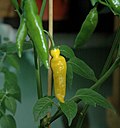Capsicum baccatum: Difference between revisions
CSV import |
CSV import |
||
| Line 20: | Line 20: | ||
[[Category:Crops originating from the Americas]] | [[Category:Crops originating from the Americas]] | ||
{{plant-stub}} | {{plant-stub}} | ||
<gallery> | |||
File:Pimiento_campanilla.jpg|Capsicum baccatum | |||
File:AjiMochica.jpg|Capsicum baccatum | |||
File:Capsicum_baccatum_flower_02.jpg|Capsicum baccatum flower | |||
File:Bishop's_crown_fruit_on_plant.jpg|Bishop's crown fruit on plant | |||
File:Capsicum_bacatuum_flower.jpg|Capsicum baccatum flower | |||
File:C_baccatum_lemon_drop_fruit.jpg|Lemon drop fruit | |||
File:Ají_peruano.jpg|Ají peruano | |||
</gallery> | |||
Latest revision as of 11:09, 18 February 2025
Capsicum baccatum is a member of the genus Capsicum, and is one of the five domesticated species of chili pepper. It is native to South America and western South America, and is cultivated for its fruit, which is commonly used in cuisine.
Description[edit]
Capsicum baccatum is a perennial plant that can reach up to 1.5 meters in height. The plant produces white or yellowish flowers, which are followed by the fruit. The fruit of Capsicum baccatum is a berry that can vary in size, shape, and color. The fruit is typically yellow or red when ripe, and has a distinctive, slightly fruity flavor.
Cultivation[edit]
Capsicum baccatum is cultivated in various parts of the world, particularly in South America. It is a warm-weather plant that requires a long growing season. The plant is typically grown from seed, and requires well-drained soil and full sun.
Uses[edit]
The fruit of Capsicum baccatum is used in a variety of culinary applications. It is often used fresh, but can also be dried or pickled. The fruit is a common ingredient in salsa, hot sauce, and other spicy foods. In addition to its culinary uses, Capsicum baccatum is also used in traditional medicine in some cultures.
See also[edit]
-
Capsicum baccatum
-
Capsicum baccatum
-
Capsicum baccatum flower
-
Bishop's crown fruit on plant
-
Capsicum baccatum flower
-
Lemon drop fruit
-
Ají peruano







